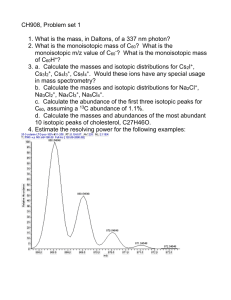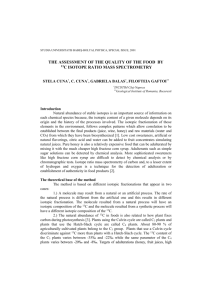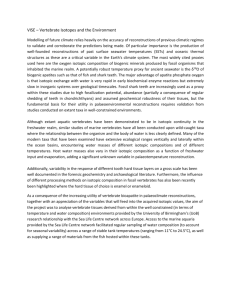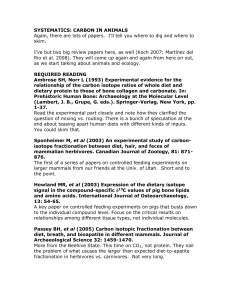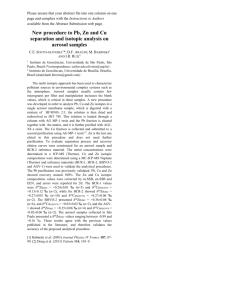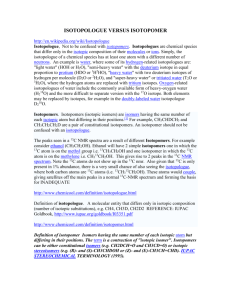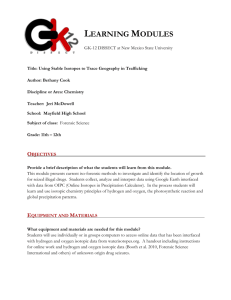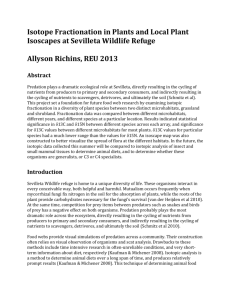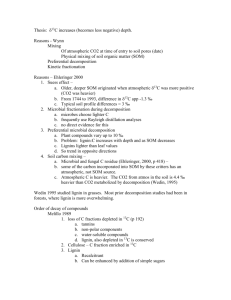Answers, PS1
advertisement
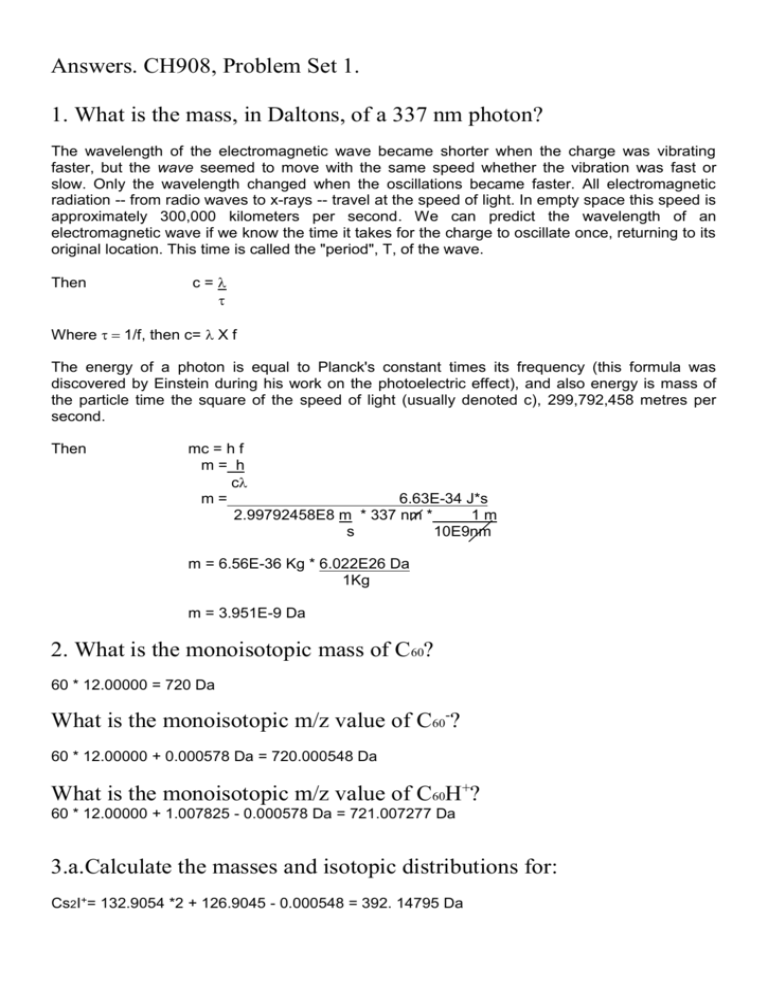
Answers. CH908, Problem Set 1. 1. What is the mass, in Daltons, of a 337 nm photon? The wavelength of the electromagnetic wave became shorter when the charge was vibrating faster, but the wave seemed to move with the same speed whether the vibration was fast or slow. Only the wavelength changed when the oscillations became faster. All electromagnetic radiation -- from radio waves to x-rays -- travel at the speed of light. In empty space this speed is approximately 300,000 kilometers per second. We can predict the wavelength of an electromagnetic wave if we know the time it takes for the charge to oscillate once, returning to its original location. This time is called the "period", T, of the wave. Then c = Where 1/f, then c= X f The energy of a photon is equal to Planck's constant times its frequency (this formula was discovered by Einstein during his work on the photoelectric effect), and also energy is mass of the particle time the square of the speed of light (usually denoted c), 299,792,458 metres per second. Then mc = h f m= h c m= 6.63E-34 J*s 2.99792458E8 m * 337 nm * 1m s 10E9nm m = 6.56E-36 Kg * 6.022E26 Da 1Kg m = 3.951E-9 Da 2. What is the monoisotopic mass of C60? 60 * 12.00000 = 720 Da What is the monoisotopic m/z value of C60-? 60 * 12.00000 + 0.000578 Da = 720.000548 Da What is the monoisotopic m/z value of C60H+? 60 * 12.00000 + 1.007825 - 0.000578 Da = 721.007277 Da 3.a.Calculate the masses and isotopic distributions for: Cs2I+= 132.9054 *2 + 126.9045 - 0.000548 = 392. 14795 Da Cs3I2+= 132.9054 *3 + 126.9045 * 2 - 0.000548 = 652.524705 Da Cs4I3+= 132.9054 *4 + 126.9045 *3 - 0.000548 = 912.334615 Da Cs5I4+= 132.9054 *5 + 126.9045 * 4 - 0.000548 = 1172.144525 Da Would these peaks have any special analytical use in mass spectrometry? Calibration b. Calculate the masses and isotopic distributions for: Na235Cl+ = 22.989770 *2 + 34.968853 - 0.000548 = 80.947845 Da Na237Cl+ = 22.989770 *2 + 36.965903 - 0.000548 = 82.944895 Da `m/z 80.948 Abundance % 75 82.945 25 Na335Cl2+= 22.989770 *3 + 34.968853 * 2 - 0.000548 = 138.906468 Da Na335Cl 37Cl+= 22.989770 *3 + 34.968853 * 1 + 34.968853 * 1 - 0.000548 Na337Cl2+ = 22.989770 *3 + 36.965903 * 2 - 0.000548 = 142.900568Da = 140.903518 Da Isotopic No. 0 138.906362 Abundance % 56.25 1 140.903462 37.50 2 142.900562 6.25 m/z Na435Cl3+= 22.989770 *4 + 34.968853 * 3 - 0.000548 = 196.865091 Da Na435Cl237Cl1+= 22.989770 *3 + 34.968853 *2 + 34.968853 *1 - 0.000548 = 198.862141 Da Na435Cl137Cl2+= 22.989770 *3 + 34.968853 *1 + 34.968853 *2 - 0.000548 = 200.859191 Da Na437Cl3+ = 22.989770 *4 + 36.965903 * 3 - 0.000548 = 202.856241 Da Isotopic No. m/z Abundance % 0 1 2 196.864932 198.862032 200.859132 42.1875 42.1875 14.0625 3 202.856232 1.5625 Na535Cl4+= 22.989770 *5 + 34.968853 * 4 - 0.000548 = 254.823714 Da Na535Cl337Cl1+= 22.989770 *3 + 34.968853 * 3 + 34.968853 * 1 - 0.000548 = 256.820764 Da Na535Cl237Cl2+= 22.989770 *3 + 34.968853 * 2 + 34.968853 * 2 - 0.000548 = 258.817814 Da Na535Cl137Cl3+= 22.989770 *3 + 34.968853 * 1 + 34.968853 * 3 - 0.000548 = 260.814864 Da Na537Cl4+= 22.989770 *5 + 36.965903 * 4 - 0.000548 = 262.811914 Da Isotopic No. 0 1 254.823502 256.820602 Abundance % 31.6406 21.0938 2 258.817702 0.3906 3 4 260.814802 262.811902 4.6875 42.1875 m/z c. Calculate the masses and abundances of the first three isotopic peaks for C60, assuming a 13C abundance of 1.1 %. Isotopic No. 0 1 2 m/z 720 721.0034 722.0067 Abundance % 51.4965 34.3657 11.2757 d. Calculate the masses and abundances of the most abundant 10 isotopic peaks of cholesterol, C27H46O. Isotopic No. m/z Abundance % 0 1 2 3 4 5 6 7 8 9 386.355 387.358 388.360 387.361 389.362 388.363 388.359 389.361 387.359 389.365 74.0302 22.2315 3.3665 0.51 0.30 0.15 0.15 0.05 0.03 0.02 Heavy isotope composition monoisotopic 13C 1 13C 2 2H 1 13C 3 13C 2H 1 1 18O 1 13C 18O 1 1 17O 1 13C 2H 2 1 4. Estimate the mass resolving power for the following examples: Mass Resolving Power (FWHM) = = m m FW HM 868.54548 = 1447.6 868.3 868.9 Mass Resolving Power (FWHM) = = m m FW HM 868.50183 = 72375.2 868.501 868.49 5. What elemental compositions are possible for a positive ion molecule of mass 386.3542 +/- 5 ppm? Assume Carbon, Hydrogen, Oxygen, Nitrogen, and Sulfur. C20H44N5O2 C22H48N3S C22H46N2O3 C24H50OS C25H44N3 C27H46O 386.34949800 – 0.00470200 386.35689300 + 00269300 386.3508400 - 0.00336000 386.35823500 + 0.00403500 386.35352200 - 0.00067800 386.35486400 - 0.00066400 What about a neutral fragment loss of 43.0184 +/- 100 ppm? HN3 C2H3O 43.017047 - 0.001353 43.018389 - 0.000011 Explain how you determine the possible compositions. First you need to calculate the upper limits: Carbon = 386.3542 = 32.2 12 Nitrogen = 386.3542 = 28 14 Hydrogen = 386.3542 = 386.3542 1 Sulfur = Oxygen = 386.3542 = 24 16 386.3542 = 12 32 With all tose limits you shall put them on a worksheet until you get the value +/- 5 ppm. 6. Calculate the R+DB of each elemental composition listed in question 5. r+db = X Y Z 1, 2 2 with X = C, Si Y = H, Cl, F Z = N, P Structure C20H44N5O2 C22H48N3S C22H46N2O3 C24H50OS C25H44N3 C27H46O HN3 C2H3O X Y 20 22 22 24 25 27 0 2 Z 44 48 46 50 44 46 1 3 5 3 2 0 3 0 3 0 dbe 1.5 0.5 1 0 5.5 5 2 1.5 7. How many hydrogen, oxygen, carbon, nitrogen, chlorine, bromine, phosphorus, and sulfur atoms are possible in the following example isotopic patterns? This spectrum could indicate a molecule of mass 38 which could form an abundant fragment ion y the loss of two hydrogen atoms (m/z 36, [M-2]+). This hints in the text should lead to the observation in Table 2.1 of the 3/1 abundance ratio of the natural chlorine isotopes, masses 35 and 37. Tus, the spectrum is a mixture of H35Cl and H37Cl, in proportions correspondinf to the sotopic abundantes of 35Cl and 37 Cl. Hydrogen Cloride Methyl bromide Sulfur dioxide C9H8O The abundante of the m/z 78 peak shows immediately that no “A+1” elements, Table2.2 tell us that the posibilitéis are C3 and C2N3. The m/z 76 molecular ion can not contain an add number of nitrogen atoms so that c3 is correct. A posible combination of “A” elements is H9P. (C3H2F2 could not fragment to yield m/z 73) C3H9P
